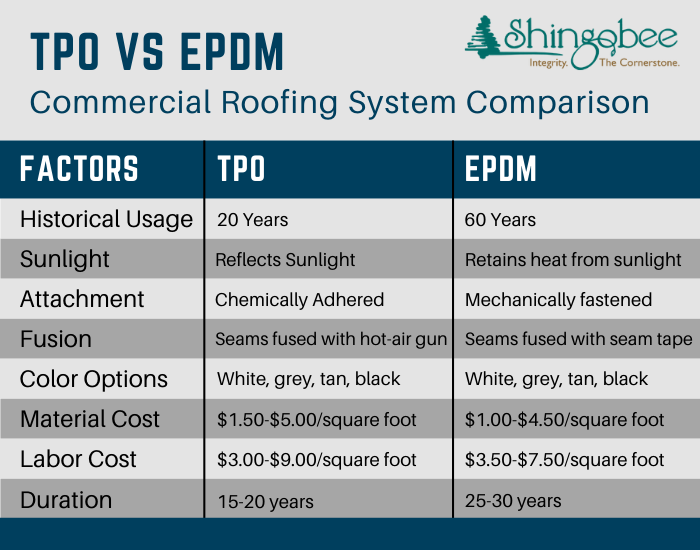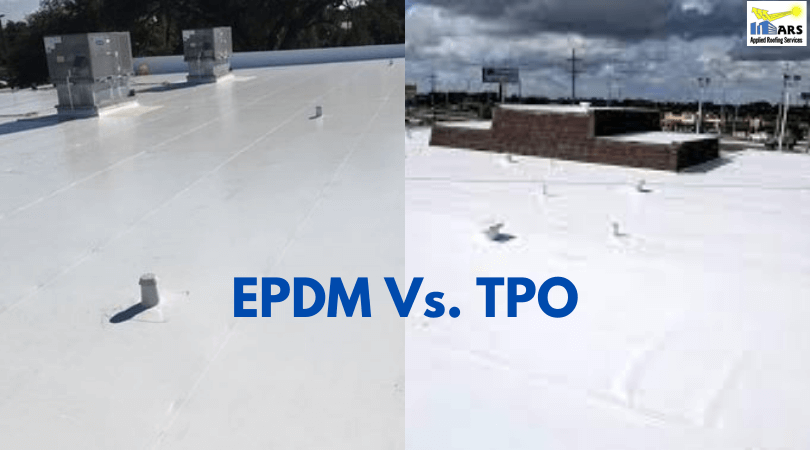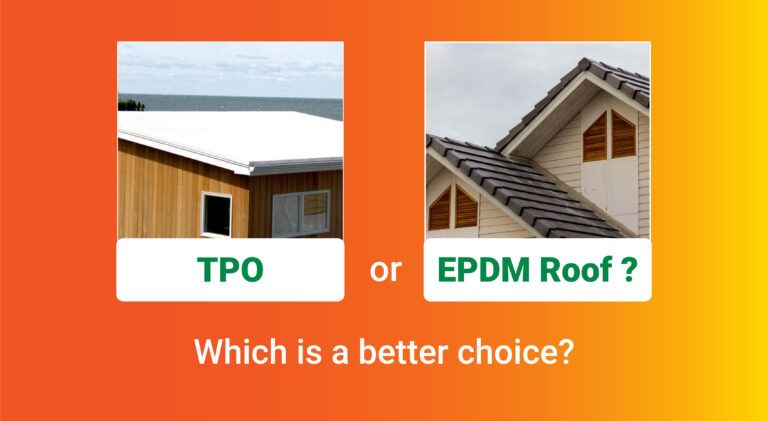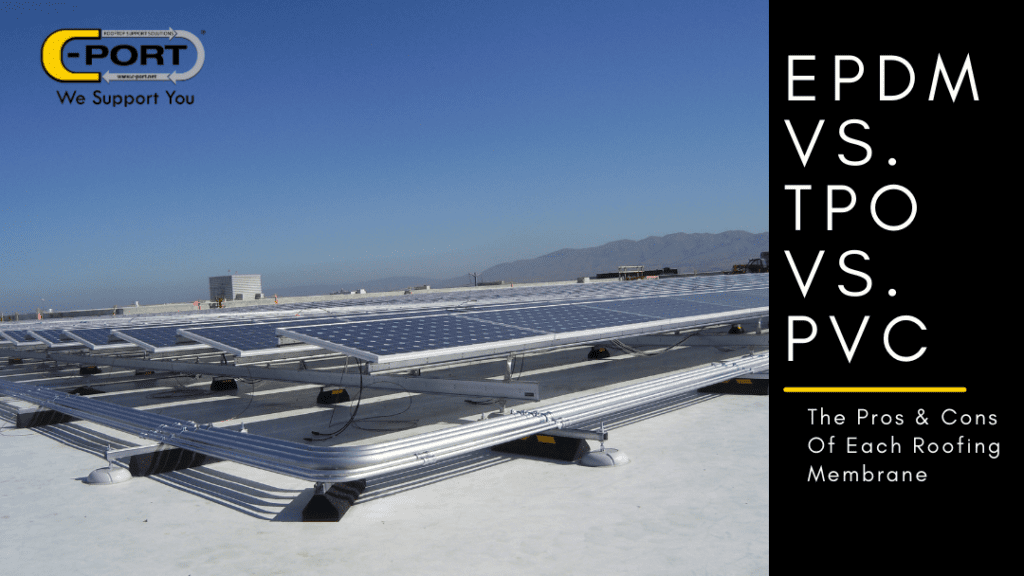When it comes to choosing the roofing material for your property, cost is always a key consideration. In this article, we will explore the price difference between two popular options: TPO and EPDM. Each roofing system has its own advantages and disadvantages, but which one will be more expensive? Is it TPO or EPDM? Let’s uncover the answer together, as we dive into the world of roofing costs.
1. Understanding TPO and EPDM
1.1 What is TPO?
Thermoplastic Olefin (TPO) is a type of single-ply roofing membrane that is widely used in commercial and residential construction projects. It is made of a blend of plastic and rubber, which gives it a flexible and durable nature. TPO membranes are known for their resistance to UV radiation, punctures, and tears, making them a popular choice for roofs.
1.2 What is EPDM?
Ethylene Propylene Diene Monomer (EPDM) is another popular roofing material known for its durability and longevity. EPDM is a synthetic rubber membrane that is primarily made from ethylene and propylene. It is non-toxic, weather-resistant, and can withstand extreme temperatures, making it suitable for various climates and roof types.
1.3 Key differences between TPO and EPDM
While both TPO and EPDM are widely used in the roofing industry, there are several key differences between the two materials. TPO has a smoother and more reflective surface, which can help reduce energy costs by reflecting sunlight. EPDM, on the other hand, is known for its superior resistance to hail and punctures. Additionally, TPO is available in a wider range of colors, allowing for greater aesthetic customization.
2. Factors Influencing Cost
2.1 Material Cost
The cost of the roofing material itself is a significant factor in determining the overall cost of a roofing project. TPO and EPDM materials vary in price, and it is essential to assess the cost implications before making a decision.
2.2 Installation Cost
The cost of installation includes labor expenses, equipment costs, and any additional materials required for the installation process. The complexity of the roof design and the expertise of the contractor can also influence the installation cost.
2.3 Maintenance Cost
Regular maintenance plays a crucial role in prolonging the lifespan of a roof. The cost of maintaining TPO and EPDM roofs may vary, depending on the specific requirements and condition of the roof. It is important to consider the long-term maintenance expenses when evaluating the overall cost of ownership.
2.4 Warranty Cost
Roofing materials often come with warranties that cover defects, repairs, or replacements. Assessing the warranty options and associated costs is important when considering the long-term cost of owning a TPO or EPDM roof.

3. Material Cost Comparison
3.1 TPO Material Cost
The cost of TPO materials can vary depending on the thickness, brand, and quality of the membrane. On average, TPO is more cost-effective compared to EPDM. However, it’s crucial to consider the specific requirements and durability needs of the project when making a decision based on material cost alone.
3.2 EPDM Material Cost
EPDM materials are generally considered to be more costly than TPO materials. The prices can vary based on factors such as thickness, brand, and quality. However, the longevity and durability of EPDM may offset the initial higher cost, providing long-term cost benefits.
3.3 Price Fluctuations
It’s important to note that material costs can fluctuate due to factors such as market demand, supply chain disruptions, and economic conditions. Monitoring market trends and working closely with suppliers can help ensure that you are aware of any price fluctuations that may impact your material costs.
4. Installation Cost Comparison
4.1 TPO Installation Cost
The installation cost for TPO roofing systems depends on various factors, including the size and complexity of the roof, labor expenses, and any additional materials or equipment needed. On average, TPO installations tend to be less expensive compared to EPDM due to the ease of installation and the reduced time required for completion.
4.2 EPDM Installation Cost
EPDM installations may be slightly more expensive compared to TPO due to the labor and expertise required for the installation process. The larger and more complex the roof design, the higher the installation cost may be. However, EPDM’s durability and resistance to hail and punctures can provide long-term savings by reducing the need for repairs and replacements.
4.3 Labor Expenses
The cost of labor can significantly impact the installation cost. It is essential to hire experienced and reputable roofing contractors who have expertise in installing TPO or EPDM roofs. Hiring skilled labor can ensure proper installation and minimize the risk of future issues, ultimately saving on potential expenses.
4.4 Complexity of Installation
The complexity of the roof design can also affect the installation cost. Roofs with multiple levels, slopes, or unique architectural features may require additional time and effort during the installation process. This complexity can impact both the labor expenses and the overall installation cost.

5. Maintenance Cost Comparison
5.1 TPO Maintenance Cost
TPO roofs typically require minimal maintenance, making them cost-effective in the long run. Regular inspections, cleaning debris, and addressing any minor issues promptly can help extend the lifespan of a TPO roof. The overall maintenance cost for TPO is relatively low compared to many other roofing materials.
5.2 EPDM Maintenance Cost
EPDM roofs also have low maintenance requirements, but they may require more frequent inspections due to their susceptibility to punctures. While the maintenance costs for EPDM roofs can be higher than those for TPO roofs, the durability and longevity of EPDM can lead to long-term savings by reducing the need for major repairs or replacements.
5.3 Repairs and Replacement
The cost of repairs and replacements can vary depending on the extent of damage and the specific requirements of the project. EPDM roofs are generally more resistant to hail and punctures, reducing the frequency and cost of repairs compared to TPO roofs. However, in the event of damage, EPDM repairs may be more complicated and costly than TPO repairs.
5.4 Lifespan Impact
Both TPO and EPDM have considerable lifespans, typically ranging from 20 to 30 years or more with proper maintenance. The longevity of a roofing material can significantly impact the overall cost of ownership. Investing in a more expensive material that has a longer lifespan may result in higher upfront costs but can provide long-term savings by reducing the frequency of replacements.
6. Warranty Cost Comparison
6.1 TPO Warranty Cost
The warranty options for TPO roofs vary depending on the manufacturer and specific product chosen. It is essential to consider the terms and conditions of the warranty, including any associated costs. While TPO warranties tend to be less expensive compared to EPDM warranties, it is crucial to evaluate the coverage and ensure it meets your project’s requirements.
6.2 EPDM Warranty Cost
EPDM warranties might come at a higher cost compared to TPO warranties due to its superior durability and resistance to damage. The warranty coverage should be carefully reviewed to determine if the associated cost is justifiable based on the specific project needs and expected lifespan of the roof.
6.3 Inspections and Certifications
Some warranties may require regular inspections and certifications to maintain their validity. It is important to consider the cost of these inspections and any potential penalties or additional expenses associated with warranty compliance. Compliance with warranty requirements can help ensure that any potential issues are identified and addressed promptly, minimizing the risk of costly repairs.

7. Total Cost of Ownership
7.1 Evaluating Material Cost, Installation Cost, Maintenance Cost, and Warranty Cost
To determine the total cost of ownership for a TPO or EPDM roof, it is crucial to evaluate all the factors discussed above. This includes considering the material cost, installation cost, maintenance cost, and warranty cost. By analyzing these aspects collectively, you can make an informed decision based on your budget and project requirements.
7.2 Long-Term Cost Analysis
When evaluating the total cost of ownership, it is important to consider the long-term cost implications. This includes assessing the anticipated lifespan of the roofing material, the potential for repairs or replacements, and any future maintenance expenses. A thorough long-term cost analysis can help identify the most cost-effective roofing solution for your specific project.
7.3 Return on Investment (ROI)
Calculating the return on investment is an essential step in determining the cost-effectiveness of a roofing system. By comparing the initial investment with the expected savings and benefits over the lifetime of the roof, you can assess the ROI. Factors such as energy efficiency, durability, and maintenance requirements should be considered when evaluating the ROI for TPO and EPDM roofs.
8. Environmental Factors and Cost Considerations
8.1 Sustainability Comparison
Sustainability is an important consideration when evaluating roofing materials. Both TPO and EPDM have eco-friendly characteristics, but there are differences to note. TPO is recyclable, making it a more sustainable option. EPDM, while not recyclable, has a longer lifespan and requires fewer replacements, reducing waste over time.
8.2 Energy Efficiency
Energy efficiency is a significant cost consideration, especially in regions with extreme weather conditions. TPO roofs are known for their reflective properties, which can help reduce cooling costs by minimizing heat absorption. EPDM roofs have moderate reflectivity, and additional insulation may be required to achieve optimal energy efficiency.
8.3 Environmental Impact
Considering the overall environmental impact of a roofing material is essential. TPO and EPDM roofs have minimal environmental impact during their lifespan. However, it is crucial to assess factors such as manufacturing processes, carbon footprint, and disposal methods when determining the eco-friendliness of these materials.
8.4 Regulatory Factors
Local regulations and building codes may impact the choice of roofing material, installation requirements, and associated costs. It is important to consult the local authorities and ensure compliance with any specific regulations pertaining to TPO and EPDM roofs. Understanding the regulatory landscape can help avoid potential penalties or delays that may affect the overall project cost.

9. Other Factors to Consider
9.1 Geographic Location
The geographical location of the project can influence the choice between TPO and EPDM roofs. Factors such as climate, temperature fluctuations, and exposure to extreme weather conditions should be considered. Consulting with local roofing experts can help determine which material performs best in a particular area, considering the long-term cost implications.
9.2 Roof Design and Complexity
The design and complexity of the roof can impact the choice of roofing material and the associated costs. Roofs with multiple slopes, valleys, or unique architectural features may require additional installation expertise, increasing the overall cost. Assessing the specific requirements of the roof design is crucial when considering TPO or EPDM.
9.3 Project Requirements
Each roofing project comes with unique requirements that should be carefully evaluated when choosing between TPO and EPDM. Consider factors such as anticipated foot traffic, aesthetic preferences, and additional features like rooftop equipment or green roofs. Evaluating project-specific needs can help ensure that the chosen roofing material is the most cost-effective option.
9.4 Contractor Expertise
Working with an experienced and reputable roofing contractor can impact the overall cost and quality of the installation. It is important to choose a contractor who has expertise in installing both TPO and EPDM roofs and can provide references or examples of past installations. Hiring a qualified professional can help prevent costly mistakes and ensure a successful roofing project.
10. Making the Right Choice
10.1 Cost vs. Benefits Analysis
When making a decision between TPO and EPDM roofing systems, it is crucial to conduct a cost vs. benefits analysis. Consider the short-term costs, long-term savings, and potential advantages of each option. This analysis should be based on the specific project requirements, budget limitations, and desired lifespan of the roof.
10.2 Prioritizing Factors
Prioritize the factors that are most important to your project’s success and align with your budget. Some projects may prioritize upfront material costs, whereas others may prioritize durability and long-term savings. Understanding your priorities can help guide you towards the most cost-effective roofing solution.
10.3 Consulting Professionals
Consulting with roofing professionals, architects, or industry experts can provide valuable insights when making the final decision. Discussing your project requirements, budget, and concerns can help professionals provide tailored recommendations that align with your goals. Their expertise can help you navigate the complexities of choosing the right roofing material and ensure a successful roofing project.
In conclusion, choosing between TPO and EPDM roofs involves weighing various factors, including material cost, installation cost, maintenance cost, warranty cost, and environmental considerations. By thoroughly evaluating these factors, conducting a cost vs. benefits analysis, and consulting with industry professionals, you can make an informed decision that balances cost-effectiveness and long-term performance for your roofing project.
